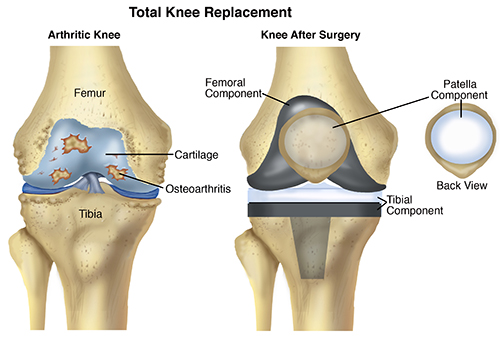Get The Facts On Total Knee Replacement
Here are a few quick facts on knee replacement surgery:
What is a total knee replacement?
 A total knee replacement is a surgical procedure whereby the diseased knee joint is replaced with artificial material. The knee is a hinge joint that provides motion at the point where the thigh meets the lower leg. The thighbone (or femur) abuts the large bone of the lower leg (tibia) at the knee joint.
A total knee replacement is a surgical procedure whereby the diseased knee joint is replaced with artificial material. The knee is a hinge joint that provides motion at the point where the thigh meets the lower leg. The thighbone (or femur) abuts the large bone of the lower leg (tibia) at the knee joint.
During a total knee replacement, the end of the femur bone is removed and replaced with a metal shell. The end of the lower leg bone (tibia) is also removed and replaced with a channeled plastic piece with a metal stem. Depending on the condition of the kneecap portion of the knee joint, a plastic “button” may also be added under the kneecap surface. The artificial components of a total knee replacement are referred to as the prosthesis.
The posterior cruciate ligament is a tissue that normally stabilizes each side of the knee joint so that the lower leg cannot slide backward in relation to the thighbone. In total knee replacement surgery, this ligament is either retained, sacrificed, or substituted by a polyethylene post. Each of these various designs of total knee replacement has its own particular benefits and risks.
Know the risks of undergoing a total knee replacement
Risks of total knee replacement include things such as blood clots in the legs that can travel to the lungs (known as Pulmonary Embolism).
Pulmonary Embolism can cause:
Other risks include:
Risks of anesthesia include:
Pre-operative evaluation for total knee replacement
Before surgery, the joints adjacent to the diseased knee (hip and ankle) are carefully evaluated. This is important to ensure optimal outcome and recovery from the surgery. Replacing a knee joint that is adjacent to a severely damaged joint may not yield a significant improvement in function as the nearby joint may become more painful if it is abnormal.
What happens in the post-operative and recovery period from surgery?
A total knee replacement generally requires between one and a half to three hours of operative time. Post-surgery, patients are taken to a recovery room, where vital organs are frequently monitored. When stabilized, patients are returned to their hospital room.


